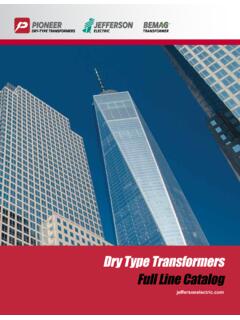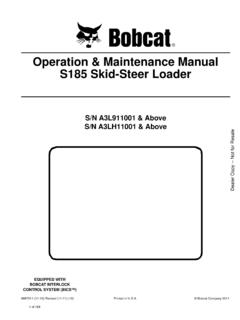Transcription of Transformer Installation, Operation, and Maintenance …
1 004-0987-000 Page 1 of 8 Transformer installation , Operation, and Maintenance Manual INTRODUCTION .. 2 inspection UPON 2 2 installation & OPERATING 2 Transformer MOUNTING & 2 2 WIRE SELECTION.. 2 inspection DURING 2 installation 3 INSTALLING 3 CABLE TERMINATION ..3 TORQUE VALUES FOR SCREWS AND 3 Transformer 5 GUIDES FOR MINIMIZING Transformer 5 Transformer design FEATURES .. 5 VENTILATED ENCLOSURE 5 ENCAPSULATED ENCLOSURE INSULATION 5 SYSTEM 6 Transformer 6 CIRCUITS, TAPS AND 6 Transformer TURNS 6 6 OPTIONAL 7 WEATHER SHIELDS FOR OUTDOOR 7 WALL MOUNTING 7 Electrical potentials hazardous to human life can exist within this equipment when energized. Disconnect all input power before opening case or touching internal parts.
2 Use proper lock-out/tag-out procedures. The information contained herein may not cover all variations in equipment or provide for all contingencies which might be met in installation , operation and Maintenance . Failure to follow instructions may result in death or serious injury IMPORTANT: Save this instruction sheet for future use of the product 004-0987-000 Page 2 of 8 INTRODUCTION This manual covers 600 volt class single phase and three phase transformers . Both ventilated (cabinet style) and Encapsulated (potted) styles are covered in this manual. These instructions set out the limiting factors for satisfactory performance of the transformers . The information contained herein outlines and describes the proper inspection , installation and Maintenance of dry type transformers .
3 inspection upon Receiving transformers should be carefully inspected upon receipt to ensure that no damage has occurred during shipment. Any damage should be reported at once and a claim should be placed against the transportation company. Storage transformers should be stored in a dry location of uniform temperature in their original packing. If storage of an unpacked Transformer is to continue for an extended length of time, all ventilating openings should be covered to keep out dust. Outdoor storage is to be avoided, but if necessary, the Transformer must be fully protected against moisture and foreign materials. Condensation and absorption of moisture can be reduced by the use of heaters. If the Transformer has been subjected to moisture or condensation, it should be dried out before energizing. installation & OPERATING SAFETY transformers are provided with access covers to facilitate installation and should never be operated without these access covers securely mounted in place.
4 A safety program must be established, verified and followed by all personnel involved with the Transformer . Transformer Mounting & Spacing Air cooled transformers depend upon the surrounding air for cooling. The free flow of air is important as is the air temperature. A Transformer must be mounted so that air can freely circulate all around and through it. A Transformer room must have adequate ventilation and should not be used for storage. Ventilated Style Do not place combustible materials on or near Transformer or mount Transformer closer than 6 inches from any adjacent wall. Encapsulated Style Do not place combustible materials on or near Transformer or mount Transformer closer than 3 inches from any adjacent wall (other than the wall the unit is mounted on). Units should always be mounted vertically. transformers must never be mounted next to or above heat generating equipment.
5 Grounding Ventilated core and coil assemblies are solidly grounded to the enclosure. On units equipped with electrostatic shields, the shields are grounded to the core. Encapsulated units have a ground stud located in the wiring compartment. On units equipped with electrostatic shields, the shield wire is connected to the ground stud. The enclosure should in turn be grounded securely and effectively as a safety precaution. Grounding must be in accordance with NEC and local electrical codes. Wire Selection Connection cables must be rated for at least 90 degrees C insulation and 75 degree C ampacity. Connection cables must meet NEC and local electrical codes. inspection during installation The Transformer should be carefully inspected for any damage due to handling after receipt. The nameplate rating on the unit should be checked against the job specifications to ensure installation of the correct Transformer .
6 The Transformer should be connected only as described on its nameplate. Taps should be adjusted, if necessary, to match the available line voltage. Any bolted electrical connections, including taps, should be checked and tightened since fasteners may have loosened during shipment. Ventilated Core and coil hold down nuts (see figure 1) should be loosened to reduce possible sound transmission to the case. The hold-down nuts are designed to be loosened, not removed. Removal will destroy the bolt threads. Only qualified personnel should install, inspect, or maintain transformers since the normal operating voltages can be hazardous. 004-0987-000 Page 3 of 8 installation Procedures 1.
7 Ensure the area is well ventilated and free from explosive or corrosive gas or vapors. 2. Check the Transformer nameplate and verify that it is the correct kVA, frequency, line and load voltage for the application 3. Mount the Transformer securely 4. Shut off primary voltage using approved lock-out/tag-out procedures 5. Remove the cover over the wiring compartment. ---------------------------------------- -------------------- Note: On ventilated transformers the bottom screws should be loosened and not removed for easier replacement of the cover. See Figure 1 ---------------------------------------- -------------------- 6. Adjust primary taps if necessary and insulate any unused taps individually. Before changing taps, the protective coating must be removed from the top and bottom of each tap. The tap s surface must be clean and coated with electrical compound before bolting the wire. 7. Route wires into enclosure using the predefined access holes or by creating holes as needed.
8 On ventilated units the wires should enter the unit below the terminals and in front of the coil. See Figure 2 8. Connect the Transformer primary according to the wiring diagram on the nameplate. -SEE CABLE TERMINATION 9. Ground the enclosure in accordance with NEC and local electrical codes. 10. Energize the unit and check the secondary voltage to ensure it is proper for the load. 11. Shut off the primary voltage using approved lock-out/tag-out procedures 12. Connect the load to the secondary terminals according to the wiring diagram on the nameplate -SEE CABLE TERMINATION ---------------------------------------- --------------------------- Note: After installation of cables and connectors, a minimum of 1 clearance should be maintained between the enclosure and any energized parts ---------------------------------------- -------------------- 13. Replace the cover over the wiring compartment 14. Energize the unit.
9 Figure 1 - Front view of Ventilated unit Figure 2 Side & Bottom View of Ventilated unit Installing Outdoors Select appropriate location to meet applicable codes, cable installation and mounting hardware. Use weather shield on ventilated units Use water tight couplings on all electrical connections Cable Termination To help guard against overheating, the following procedure is recommended when connecting the cables: Strip the cable of its insulation to the desired length without ringing or nicking the wire. 004-0987-000 Page 4 of 8 Apply a suitable joint compound (such as a PENETROX A, ALNOX-UG, T&B21059, etc.) to the exposed wire and wire brush through it to remove any oxide film from the other strands.
10 Insert the wire into the lug. Make certain all the strands are contained and then tighten the wire retaining screw securely per Table A. This operation should result in compound oozing out from between the individual strands of the wire. If this does not happen, it is an indication that an insufficient quantity of compound was used. Wipe the excess compound from the area adjacent to the wire connection. Note: Some compounds contain metallic particles, which could reduce the dielectric strength of the insulating material employed. After a few seconds, re-tighting the wire retaining screw per Table A. Coat both surfaces with a copper-aluminum joint compound. Bend the cable so the hole in the lug aligns with the hole in the terminal and contact surfaces are in good contact alignment. Insert the bolt with a flat washer under the head through the holes of the lug and the terminal. Add a flat washer, lock washer and a nut on the opposite side (see Figure 3).

